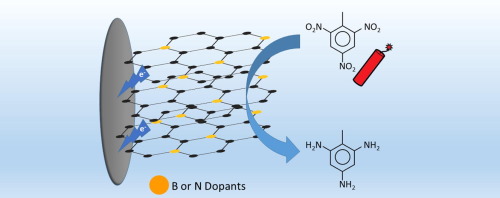Electrochemistry Communications ( IF 5.4 ) Pub Date : 2020-01-25 , DOI: 10.1016/j.elecom.2020.106660 Nasuha Rohaizad , Zdeněk Sofer , Martin Pumera

|
A multitude of strategies to alter the properties of graphene, a representative two-dimensional material, has been proposed, with the aim of improving its performance and capabilities. Whilst in general doping with any element is reported in the literature as an electrochemistry enhancing process, there is no real reason for dopants to always be beneficial. Here we doped graphene with boron or nitrogen and show that they have completely opposite properties for electrochemical detection of 2,4,6-trinitrotoluene (TNT). Nitrogen-doped graphene enhances the signal of TNT, whilst boron-doped graphene reduces the response when compared to undoped graphene. This debunks most of the papers claiming that doping results in excellent electrochemistry.
中文翻译:

石墨烯中的硼和氮掺杂剂对爆炸性硝基芳族化合物的电化学检测有相反的影响
为了改善石墨烯的性能和性能,已经提出了多种改变石墨烯(一种代表性的二维材料)的性能的策略。尽管在文献中通常将任何元素掺杂作为电化学增强工艺,但没有真正的理由使掺杂剂总是有益的。在这里,我们用硼或氮掺杂了石墨烯,表明它们具有完全相反的性质,可用于电化学检测2,4,6-三硝基甲苯(TNT)。与未掺杂的石墨烯相比,氮掺杂的石墨烯增强了TNT的信号,而硼掺杂的石墨烯则降低了响应。这颠覆了大多数声称掺杂能产生出色电化学的论文。


























 京公网安备 11010802027423号
京公网安备 11010802027423号